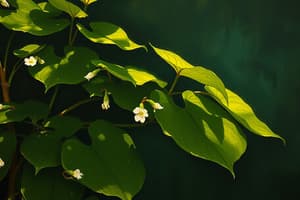Podcast
Questions and Answers
What is primarily synthesized and stored by amyloplasts?
What is primarily synthesized and stored by amyloplasts?
- Starch granules (correct)
- Lipid droplets
- Glucose granules
- Protein granules
Which structure is not part of the mitochondrion's anatomy?
Which structure is not part of the mitochondrion's anatomy?
- F F1 complexes
- Outer membrane
- Stroma (correct)
- Crista
What characteristic supports the endosymbiotic origin theory of mitochondria?
What characteristic supports the endosymbiotic origin theory of mitochondria?
- Circular DNA structure (correct)
- Ability to change shape and size
- Reproduction by binary fission (correct)
- Presence of histone proteins
What is the primary function of mitochondria?
What is the primary function of mitochondria?
Which of the following statements about prokaryotes is true?
Which of the following statements about prokaryotes is true?
What are the functions of energy organelles in a cell?
What are the functions of energy organelles in a cell?
Which of the following plastids is responsible for storing starch?
Which of the following plastids is responsible for storing starch?
Which structure within the chloroplast is directly involved in photosynthesis?
Which structure within the chloroplast is directly involved in photosynthesis?
Which characteristic is true for chloroplasts?
Which characteristic is true for chloroplasts?
What type of plastid is characterized by its lack of pigment?
What type of plastid is characterized by its lack of pigment?
What is the primary role of the thylakoid membrane within the chloroplast?
What is the primary role of the thylakoid membrane within the chloroplast?
Which of the following pigments is NOT typically found in chromoplasts?
Which of the following pigments is NOT typically found in chromoplasts?
What are proplastids categorized as?
What are proplastids categorized as?
Study Notes
Energy Organelles
- Cells require energy for growth, reproduction, movement, and responsiveness.
- Two energy-producing organelles are mitochondria and chloroplasts.
Plastids
- Membrane-bound organelles, mostly pigmented.
- Found in plants and some protists (e.g., green algae).
- Develop from proplastids (undifferentiated).
- Proplastids are found in meristematic cells of plants.
- Classified by pigment type and can change forms.
Types of Plastids
- Proplastids - undifferentiated plastids.
- Etioplasts - develop in darkness, contain precursors to chlorophyll.
- Leucoplastids - colorless, involved in storage.
- Amyloplasts - store starch.
- Elaioplasts - store lipids.
- Proteinoplasts - store proteins.
- Chloroplasts - contain chlorophyll, responsible for photosynthesis.
- Leucoplastids - colorless, involved in storage.
- Etioplasts - develop in darkness, contain precursors to chlorophyll.
Chloroplast Structure
- 4 to 6 µm in diameter, variable in size and shape.
- Bound by an outer and inner membrane.
- Inner membrane forms thylakoids (flat discs).
- Thylakoids stack to form grana.
- Grana connected by lamellae membranes.
- Embedded in a gel-like matrix called stroma.
- Stroma contains starch grains, oil bodies, DNA, enzymes, ribosomes, etc.
- Thylakoids contain chlorophyll and carotenoids (carotene, xanthophyll).
- Function: Photosynthesis.
Chromoplasts
- Spherical, elongated, or lobed in shape.
- Contain betacyanin, anthocyanin, and carotene.
- May form from other plastids.
- Have oil bodies where pigments are stored.
- Found in fruits, flowers, and roots (e.g., carrots, beetroot).
Leucoplasts
- Lack pigments and elaborate membranes.
- Contain oil bodies, starch grains, and protein bodies.
- Found in storage cells, usually not exposed to sunlight.
Mitochondria
- Vary in size and shape (sausage, spiral, or spherical).
- About 1 µm in diameter.
- Bound by double membranes.
- Inner membrane folds into projections called cristae.
- Cristae are in a gel-like matrix with enzymes, DNA, RNA, proteins, and ribosomes (70S).
- Function: Respiration.
Endosymbiotic Origin Theory
- Mitochondria and chloroplasts originated from one cell ingesting another.
- The ingested organelles (believed to be prokaryotes) were not digested and formed a symbiotic relationship with the host cell.
Characteristics Supporting Prokaryotic Origin
- Circular DNA without histones
- One or more nucleoids
- Antibiotics like chloramphenicol and streptomycin inhibit protein synthesis
- Reproduce by fission
- 70S ribosomes
- Produce proteins
Studying That Suits You
Use AI to generate personalized quizzes and flashcards to suit your learning preferences.
Related Documents
Description
Explore the fascinating world of energy organelles, focusing on mitochondria and chloroplasts. Learn about the different types of plastids, their structures, and roles in plant cells. This quiz will test your understanding of how these organelles contribute to cellular functions.




